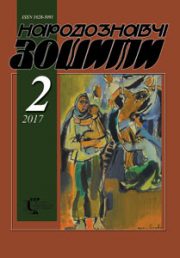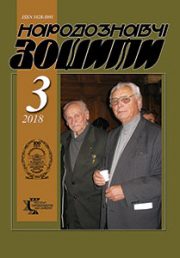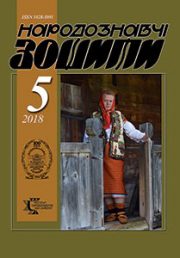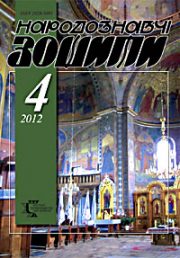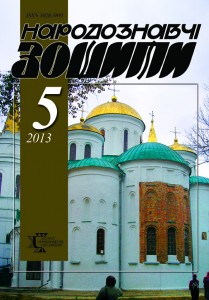
Content
Sokil Hanna. On the role of Shevchenko Scientific society in the history of ukrainian folklore studies (In Society’s 140th Anniversary). P. 775-781
In the article have been outlined all main stages in development as well as some conceptual foundations of Ukrainian folklore studies through the late XIX and the first third of the XX cc. Principal attention has been paid to Society’s organizing role in elaboration and consolidation of scientific approaches in systematized range of researches-work. Reviews of outstanding scholars’ achievements, works by Ivan Franko, Mykhailo Hrushevsky, Volodymyr Hnatiuk as members of Society and promotors of folkloristic studies has been presented.
Keywords: Shevchenko Scientific Society, Ethnographic Commission of Shevchenko Scientific Society (1898—1939), classification, generalization, scientific principles.
read »
Sokil Vasyl. Epithet in the system of imaginative-expressive means of folk creations about holodomors. P. 782-786
In the article has been considered a problem of traditional poetics in a folk prose about Holodomors with particular attention to part and place of the epithet. Its functionalism, originality and means of use have been defined and exposed. With epithets one could underline the appearance of characters as well as signs of phenomena, objects etc. especially of those being most representative for studied cycle of creations.
Keywords: Holodomor, the epithet, character, object, phenomenon.
read »
Yudova-Romanova Kateryna. Historical survey of masses’ festivals in the ancient world: Pharaonic Egypt, Sumer, Old Babylon, Assyria. P. 787-894
The article has been dedicated to a research-work on some peculiarities of masses’ festivals in the context of socio-cultural development of Ancient Egypt and Mesopotamia. Author has systematized the knowledge on masses’ festivals in the mentioned historical cultural regions and their roles in the development of civilization; comparative study as for organizing and realizations of events has been given.
Keywords: masses’ festival, theatricalized walk, festival ceremony, religious mistery, Ancient Egypt, Sumer, Old Babylon, Assyria.
read »
Hamaliya Kateryna. On most ancient towns of the world and the origin of urban life in Mesopotamia. P. 795-802
The paper is dedicated to the rise of first towns along the territories of Mesopotamia, the ancient centres of civilization emerged in the basin of two great rivers, Tigris and Euphrates. Description has been given of towns thoroughly studied by archaeologists, viz. Sumerian Ur built on the bank of Euphrates, Assyrian cities Dur-Sharrukin (nowadays Khorasabad) and Nineveh, the capital of ancient Assyria on the Tigris riverside. Main attention has been paid to town-planning, architecture of temples and palace complexes, structure of dwelled houses owned by prosperous or poor inhabitants, organization of urban water supply and removing of domestic waste. The achievements of ancient Mesopotamian builders in the field of urbanism as well as in creating the most comfortable dwellings for rulers have been underlined.
Keywords: civilization, urbanization, way of life, practical achievements.
read »
Koval Halyna. On evolving of calendar ritual tradition: magical to poetic aesthetic sphere. P. 803-810
In the article has been considered the source of calendar ritual tradition and its changes from the magical beginning to poetic, aesthetic sphere. Dominating level — the expressive one — expressed by the formula of Desire to Realization has been presented. Especial attention has been paid to calendar memory and its main factors that might enable retranslation of the human experience. The emphasis has been made on repetition, variability of traditional actions and verbal expressions.
Keywords: tradition, magical, poetic, aesthetical, calendar ritual text, folk memory.
read »
Sokil-Klepar Natalia. Dendrological motives in nominations of the Ukrainian Carpathians’ microlocations. P. 811-818
There are reviewed microtoponyms of the Ukrainian Carpathians, motivated by dendrological names in the article. Generating base in their names implements the main tree species typical for the studied region; other Slavonic parallels are given. The analyzed microtoponymic names brightly represent floral features of the Ukrainian Carpathians.
Keywords: microtoponym, geographical term, dendrological.
read »
Rebryk Olga. Persian folk tales in the context of ukrainian folklorist studies. P. 819-826
The article traces the notions of Persian folk tales, general characteristic of Persian folk tales is represented, and peculiarities of Persian folk tales are analyzed in comparison to Ukrainian folk tales, the classification of Persian folk tales is represented.
Keywords: folk tale, classification, motive.
read »
Chornopysky Mykhailo. On the origion of khrun satirical image-type. P. 827-838
The origin of Khrun image-type in Ukrainian satirical lexicon has been traced via review of Kornylo Ustyyanovych’ creative works and his Zerkalo (Mirror) news- magazine.
Кeywords: Kornylo Ustyyanovych, satirical image-type, Zerkalo (Mirror) Mykyta Khrun, Shkaralupnyk, elections, diet.
read »
Loshtyn Nazariy. Pastoral care of the monks of the monastery of St. Stephen in the town of Zolotyi Potik in the XVIII century. P. 839-851
Based on archival sources, this article has brought an outline of pastoral care by Dominican monks as a principal aspect of their activity in the parish of St. Stephуn, the town of Zolotyi Potik (now Buchach region, Ternopil obl.) and surrounding villages during the XVIII century. Attention has been paid to the service of such sacraments as baptisms, marriages, burials, confessions and public worships. The author has also attracted the readers’ attention to the practice of giving names in the course of baptism.
Keywords: Dominicans, parishbooks, pastoral care, baptism, marriage, burial, confession.
read »
Zyubrovsky Andrii. On traditional beliefs, signs, prescriptions, interdictions, restrictions and concepts related with the master-lady as a chief backer of everyday bread in ukrainians of south-estern ethnographic region during the late XIX to XXI cc.. P. 852-862
The paper has dealt with some realistic and ritual-worldview requests concerning the figure of master-lady as a main bread-backer in the traditional Ukrainian family. Author has launched his conclusion that mentioned requests were loaded with task to guarantee the backing of quality bread good enough for eating and suitable in ritual needs by means of limiting the possible negative influence of woman energies. On another hand, the complex of requests had to save the bread-backing women from the exhaustion caused the hard work on backing. In addition the author has considered some various ways for replacement of the bread-backing woman.
Keywords: bread backing, master-lady, the chthonic creatures, unclean woman, pregnancy, dough making, dough trough, man.
read »
Nykorak Olena. On originality of décor in tracery-woven zapaskas of Zhydachiv region. P. 863-874
In the article have been considered some artistic peculiarities in décor of woven zapaskas —women’s skirt-typed two-part waist outer dress still used in Transnistrian villages of Zhydachiv region, Lviv obl. In the course of study have been discovered main schemes of compositions as well as general motifs, colour ranges, means and modes of artistic expressiveness inherited by the artifacts of mentioned areal of weaving.
Keywords: tracery waving, zapaska, décor, composition, motif, artistic expressiveness.
read »
Kozakevych Olena. On the art of traditional ukrainian knitting: historical aspect. P. 875-896
The article has presented main stages in traditional Ukrainian art of knitting from the sources of craft to the early XXI c. In the course of research-work has been studied a problem as for the appearance of knitted prototypes along the ancient Ukrainian lands in prehistoric epoch; an attempt of comparative characteristics in the context of analogous European phenomena was made. Main attention has been paid to the artifacts of folk art, although with the aim of fuller enlightening of certain phenomenon and events objects of professional craft were taken into account too. Principal tendencies in formation of local features as well as some peculiarities in the typological groups of knitted ware and characteristic artistic traits have been defined. Analytic research has shown the changes in knitting, correlative ratio of traditions and influence of novation.
Keywords: knitting, technique, prototype, textile, tradition, art, exhibition, education, novation.
read »
Taras Yaroslav. On cellars in moldovan households: architectural and decorative aspects. P. 897-906
The article has thrown some light upon general meanings and traditions in architectural, constructive and decorative design of cellars in Moldova and exemplified their placements in the yards of households with relations to dwelled houses as well as types of built realization; the origins and evolvement of the mentioned objects has been traced.
Keywords: Moldova, cellar, architecture, décor.
read »
Dіdukh Anna. The applique on the clothing in the dialects of Ukraine. P. 907-919
The research-work has been dedicated to descriptions of nominations used for characterizing the appliqué in the decoration of Ukrainian clothes. The article has included the vocabulary of lexemes typical for craftsmen and population of the whole Ukraine in the late ХІХ and early ХХІ cc. The vocabulary consists of grouped terms related to the peculiarities of the decorations in Ukrainian clothes, as materials and techniques for making the appliqué, the articles of clothing decorated with appliqué, the arrangement of appliqué on the clothing).
Keywords: dialects, vocabulary, appliqué, clothing, decoration, Ukraine
read »
Hao Xiao Hua. Actual problems of chinese art during the second half XX — early XXI cс. in the context of traditions and modern aesthetic concepts. P. 920-925
The article has thrown some light upon the current processes that determined the development of Chinese art during the mentioned time. The character of impacts of Western European art on Chinese one has been disclosed. Short outline has been presented as for main stages in penetration of European oil painting in China as well as its role in renovation of traditional painting. Main attention has been paid to analytic studies of artistic phenomena appeared during period after the «cultural revolution».
Keywords: Guohua, xiyanghua, «painting scars», «rural realism», «Artists of the North», the form, content, «new paintings enlightened people of China».
read »
Hryshchenko Oleha. Teodoziya Bryzh: strokes to creative portrait. P. 926-930
The article has presented a review of creative work by Teodoziya Bryzh,widely-known Ukrainian sculptor of the second half XX c. Analytical study in thematics and artistic features of monumental and easel works have been performed.
Keywords: the plastic arts, monumental sculpture, decorative sculpture.
read »
Fediv Yurii. Present-day interview with archbishop Adam Dubiec (Sanok, Poland). P. 931-936
read »
Koshovyi Oleh. Clay, smoke and fire. P. 937-938
read »
Sheremeta O. Most eminent researcher in Ukrainian folk culture. P. 939-940
read »
Ivannykova Ludmyla. Monographic study of parental-ritual folklore. P. 941-947
read »
